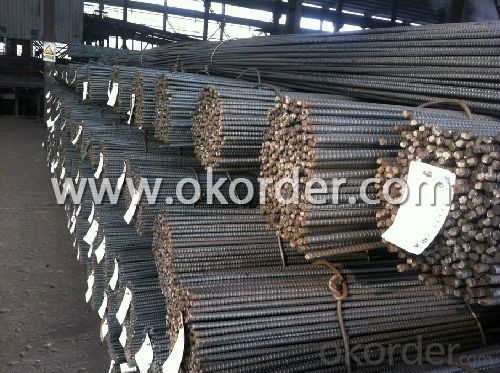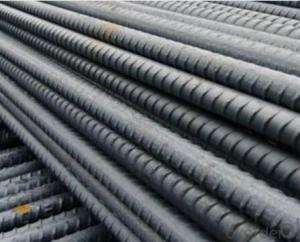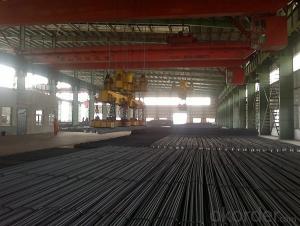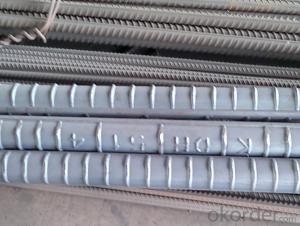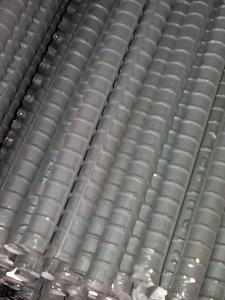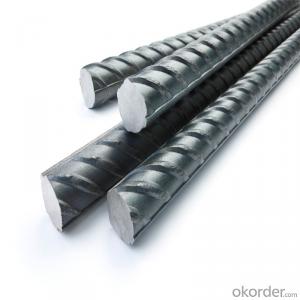Hot Rolled Steel Rebar ASTM Standard
- Loading Port:
- Tianjin
- Payment Terms:
- TT or LC
- Min Order Qty:
- 100 m.t.
- Supply Capability:
- 10000 m.t./month
OKorder Service Pledge
OKorder Financial Service
You Might Also Like
OKorder is offering Hot Rolled Steel Rebar ASTM Standard at great prices with worldwide shipping. Our supplier is a world-class manufacturer of steel, with our products utilized the world over. OKorder annually supplies products to African, South American and Asian markets. We provide quotations within 24 hours of receiving an inquiry and guarantee competitive prices.
Product Applications:
Hot Rolled Steel Rebar ASTM Standard are ideal for structural applications and are widely used in buildings, bridges, roads and other engineering construction. Big to highways, railways, bridges, culverts, tunnels, public facilities such as flood control, dam, small to housing construction, beam, column, wall and the foundation of the plate, deformed bar is an integral structure material..
Product Advantages:
OKorder's Hot Rolled Steel Rebar ASTM Standard are durable, strong, and wide variety of sizes.
Main Product Features:
· Premium quality
· Prompt delivery & seaworthy packing (30 days after receiving deposit)
· Can be recycled and reused
· Mill test certification
· Professional Service
· Competitive pricing
Product Specifications:
Standard | GB UK USA | HRB335 HRB400 HRB500 G460B, B500A, B500B,B500C GR40, GR60 | |
Diameter | 6mm,8mm,10mm,12mm,14mm,16mm,18mm,20mm, 22mm,25mm,28mm,32mm,36mm,40mm,50mm | ||
Length | 6M, 9M,12M or as required | ||
Invoicing | Actual or Theoretical Weight Basis as buyer’s request. | ||
Type | Hot rolled steel rebar | ||
Diameter(mm) | Section area (mm²) | Mass(kg/m) | Weight of 12m (kg) | Pcs/ton |
6 | 28.27 | 0.222 | 2.664 | 375.38 |
8 | 50.27 | 0.395 | 4.74 | 210.97 |
10 | 78.54 | 0.617 | 7.404 | 135.06 |
12 | 113.1 | 0.888 | 10.656 | 93.84 |
14 | 153.9 | 1.21 | 14.52 | 68.87 |
16 | 201.1 | 1.58 | 18.96 | 52.74 |
18 | 254.5 | 2.00 | 24 | 41.67 |
20 | 314.2 | 2.47 | 29.64 | 33.74 |
22 | 380.1 | 2.98 | 35.76 | 27.96 |
25 | 490.9 | 3.85 | 46.2 | 21.65 |
28 | 615.8 | 4.83 | 57.96 | 17.25 |
32 | 804.2 | 6.31 | 75.72 | 13.21 |
36 | 1018 | 7.99 | 98.88 | 10.43 |
40 | 1257 | 9.87 | 118.44 | 8.44 |
50 | 1964 | 15.42 | 185.04 | 5.40 |
FAQ:
Q1: Why buy Materials & Equipment from OKorder.com?
A1: All products offered byOKorder.com are carefully selected from China's most reliable manufacturing enterprises. Through its ISO certifications, OKorder.com adheres to the highest standards and a commitment to supply chain safety and customer satisfaction.
Q2: How do we guarantee the quality of our products?
A2: We have established an advanced quality management system which conducts strict quality tests at every step, from raw materials to the final product. At the same time, we provide extensive follow-up service assurances as required.
Q3: How soon can we receive the product after purchase?
A3: Within three days of placing an order, we will arrange production. The normal sizes with the normal grade can be produced within one month. The specific shipping date is dependent upon international and government factors, the delivery to international main port about 45-60days.
Images:
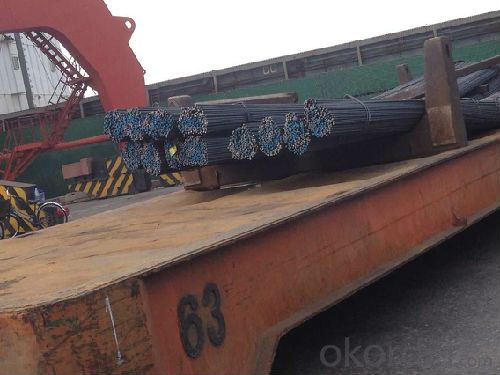
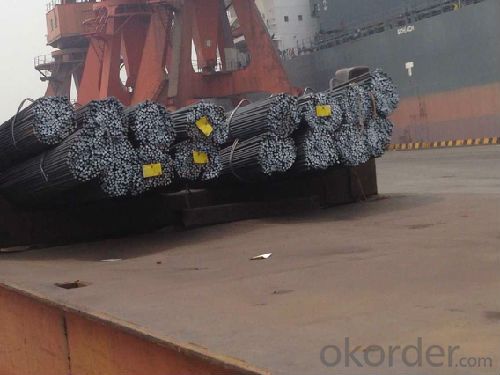
- Q: Can steel rebars be used in architectural detailing?
- Yes, steel rebars can be used in architectural detailing. They are commonly used in reinforced concrete structures to provide strength and stability. Rebars can be shaped and arranged to create intricate architectural features and provide structural support where needed.
- Q: What are the factors that determine the strength of steel rebars?
- Several factors contribute to the strength of steel rebars. Firstly, the composition of the steel used in their manufacture plays a crucial role. The presence of elements like carbon, manganese, and silicon significantly impacts the steel's strength by enhancing its ability to resist tension and provide structural stability. Secondly, the manufacturing process of rebars influences their strength. Quenching and tempering, a process involving rapid cooling after heating, is typically employed to achieve the desired strength. The precise temperature and duration of this process affect the grain structure and chemical properties of the steel, thereby impacting the rebars' strength. The size and shape of rebars also affect their strength. The diameter and length of a rebar determine its load-bearing capacity. Thicker and longer rebars generally possess higher strength as they can withstand greater stress and distribute it more effectively. Furthermore, the presence of impurities or defects in the steel can weaken rebars. Cracks, voids, or inclusions compromise the structural integrity of the rebar and reduce its strength. Finally, environmental conditions must be considered when determining the strength of rebars. Factors like temperature, humidity, and exposure to corrosive substances can impact their strength over time. Taking precautions, such as using corrosion-resistant coatings or stainless steel rebars, is essential to ensure the longevity and strength of rebars in such environments. In conclusion, the strength of steel rebars depends on the composition of the steel, the manufacturing process, the size and shape of the rebars, the presence of defects, and the environmental conditions in which they will be used. Considering these factors is crucial to ensure the durability and reliability of steel rebars in construction applications.
- Q: What are the different types of corrosion protection coatings for steel rebars?
- There are several types of corrosion protection coatings available for steel rebars, each offering different levels of protection and durability. 1. Epoxy Coatings: Epoxy coatings are one of the most common and effective corrosion protection coatings for steel rebars. They provide a thick, durable barrier that prevents moisture and corrosive substances from reaching the steel surface. Epoxy coatings can be applied by spray, brush, or dip methods and provide excellent adhesion and resistance to chemicals. 2. Zinc Coatings: Zinc coatings, such as hot-dip galvanization or zinc-rich paint, are another popular choice for corrosion protection. These coatings create a sacrificial barrier, where the zinc corrodes instead of the steel rebar. Zinc coatings are highly effective in preventing corrosion, even in harsh environments, and can be applied in various thicknesses depending on the level of protection required. 3. Fusion-Bonded Epoxy (FBE) Coatings: FBE coatings are commonly used in underground or submerged applications. These coatings are applied by heating the steel rebar, which causes the epoxy powder to melt and bond to the surface. FBE coatings provide excellent corrosion resistance and are resistant to chemicals, abrasion, and impact. 4. Polymer Coatings: Polymer coatings, such as polyurethane or polyethylene, are often used in high-temperature environments or where chemical resistance is required. These coatings provide a protective barrier that is resistant to UV radiation, abrasion, and chemicals. Polymer coatings can be applied by spray or dip methods and offer good adhesion to the steel surface. 5. Concrete Coatings: In reinforced concrete structures, the concrete itself can act as a corrosion protection coating for the steel rebars. The high alkalinity of concrete creates a protective layer around the steel, known as the passivating layer, which helps prevent corrosion. Additionally, the use of corrosion inhibitors in the concrete mix can enhance the corrosion protection of steel rebars. It is important to select the appropriate corrosion protection coating based on the specific environmental conditions, intended application, and required durability. Consulting with experts or engineers experienced in corrosion protection can help determine the most suitable coating for steel rebars in a given situation.
- Q: How do steel rebars impact the overall construction timeline?
- The speed and efficiency of the construction process are greatly influenced by the presence of steel rebars. These rebars are essential for reinforcing concrete structures, providing them with strength, durability, and resistance. To begin with, the use of steel rebars contributes to faster construction by reducing the time required for concrete to cure. When embedded in concrete, rebars evenly distribute the load, resulting in a stronger structure and expedited construction. This is especially crucial for tall buildings or large-scale projects where time is of the essence. Furthermore, steel rebars enhance the structural integrity of the construction, ensuring its ability to withstand forces like earthquakes, wind, and heavy loads. By reinforcing the concrete, rebars prevent cracks and failures, thereby increasing the longevity and safety of the building. This eliminates the need for costly repairs or renovations in the future, ultimately saving time in the long run. In addition, the use of steel rebars allows for greater flexibility in design and construction. Architects and engineers can create intricate structures with curved or irregular shapes without compromising strength or stability thanks to the presence of rebars. This versatility reduces the time required for design modifications and construction alterations, ultimately expediting the overall timeline. Moreover, steel rebars are readily available in the market and conform to specific industry standards. This ensures a consistent supply of high-quality materials, minimizing delays caused by material shortages or issues with quality. Contractors can easily obtain rebars, facilitating a smooth workflow and timely completion of the construction project. In conclusion, steel rebars have a significant impact on the overall construction timeline. They expedite the construction process, enhance structural integrity, allow for design flexibility, and ensure a consistent supply of materials. By incorporating steel rebars into construction projects, contractors can save time, reduce potential setbacks, and deliver projects within the desired timeframe.
- Q: Can steel rebars be used in wastewater treatment plant construction?
- Certainly, steel rebars are applicable for the construction of wastewater treatment plants. They are frequently utilized in the development of reinforced concrete structures, specifically in the context of wastewater treatment facilities. These rebars contribute to the concrete's enhanced strength and durability, enabling it to endure the harsh and corrosive conditions commonly encountered in such facilities. To shield the rebars from the corrosive impact of wastewater, they are typically coated with epoxy or other corrosion-resistant substances. Furthermore, the proper design and positioning of the rebars guarantee the structural soundness and longevity of the treatment plant. In conclusion, steel rebars serve as a widely employed and effective reinforcement material in wastewater treatment plant construction.
- Q: Can steel rebars be used in wind turbine tower construction?
- Yes, steel rebars can be used in wind turbine tower construction. Rebars provide strength and structural support to the tower, ensuring its stability and ability to withstand strong winds.
- Q: How are steel rebars marked for identification on construction sites?
- Various methods are commonly used to mark steel rebars for identification on construction sites. The primary method involves attaching tags or labels to the rebars, which contain crucial information like the rebar's diameter, grade, length, and any necessary specifications or codes. In addition to tags, rebars can also be marked with paint or ink. This can be achieved by either spraying or stenciling the required information directly onto the rebar's surface. Paint or ink markings are typically used for temporary identification or when using tags is not feasible. Another marking method involves using colored plastic or vinyl caps on the ends of the rebars. These caps are usually color-coded to indicate different characteristics, such as rebar size or type. This allows for easy visual identification on the construction site. It's important to note that the specific method of marking rebars may vary based on local regulations, project requirements, or the preferences of the construction company or engineer. The purpose of these markings is to ensure that rebars can be easily identified and sorted during construction, promoting proper installation and adherence to design specifications.
- Q: What are the safety precautions to be followed while working with steel rebars?
- To prevent accidents and injuries while working with steel rebars, it is essential to adhere to specific safety measures. Consider the following precautions: 1. Personal Protective Equipment (PPE): Ensure that you always wear suitable PPE, including safety glasses, gloves, hard hats, and steel-toed boots. These items will shield you from potential dangers like falling objects, sharp edges, and flying debris. 2. Training and Knowledge: Before handling steel rebars, make sure you have undergone proper training and understand the associated safety protocols. Familiarize yourself with the equipment used and comprehend the potential risks involved. 3. Proper Lifting Techniques: Handling steel rebars can be challenging due to their weight and awkward shape. Always utilize correct lifting techniques, such as bending your knees and using your legs instead of your back. Do not attempt to lift a rebar that exceeds your capacity; seek assistance if necessary. 4. Secure Storage: Store steel rebars in a designated area that is free from potential obstructions. Stack them in a stable manner to prevent toppling and causing injuries. 5. Safe Handling: When moving steel rebars, exercise caution due to their sharp edges and potential for harm. Employ appropriate lifting equipment, such as cranes or forklifts, if required. Avoid dragging or sliding rebars, as this can lead to strains or sprains. 6. Fall Protection: If working at heights or near open edges, ensure that adequate fall protection measures are in place. This may involve using guardrails, safety harnesses, or safety nets to prevent falls. 7. Fire Safety: Steel rebars can become extremely hot when exposed to heat or flames. Ensure that appropriate fire prevention measures are in place, such as fire extinguishers, and exercise caution when working near flammable materials. 8. Communication: Maintain clear communication with colleagues and supervisors to ensure everyone is aware of their surroundings and potential hazards. Utilize hand signals or radios when working in noisy environments. 9. Regular Inspections: Routinely inspect steel rebars for any defects, such as cracks or sharp edges, that could pose a safety risk. Immediately remove any damaged or faulty rebars from use. 10. First Aid and Emergency Procedures: Familiarize yourself with first aid procedures and emergency protocols in the event of accidents or injuries. Have a well-stocked first aid kit readily available on-site and know the location of the nearest medical facility. By adhering to these safety precautions, you can minimize the likelihood of accidents and injuries while working with steel rebars. Always prioritize your safety and the safety of those around you.
- Q: How are steel rebars measured and priced?
- Steel rebars are measured and priced based on their weight and length. The weight of a steel rebar is usually measured in pounds or kilograms, while the length is measured in feet or meters. The weight of a rebar is determined by its diameter, which is typically measured in millimeters or inches. To calculate the price of a steel rebar, the weight is multiplied by the cost per unit weight. The cost per unit weight can vary depending on factors such as the type of steel used, the market demand, and the supplier. This price is usually quoted in terms of cost per pound or cost per kilogram. In addition to the weight and length, other factors may also influence the pricing of steel rebars. These can include factors such as the grade of steel, the manufacturing process, and any additional treatments or coatings applied to the rebar. It is important to note that the pricing of steel rebars can vary from supplier to supplier, so it is advisable to obtain multiple quotes and compare them before making a purchasing decision.
- Q: How do steel rebars improve the load-carrying capacity of concrete?
- Steel rebars improve the load-carrying capacity of concrete through a combination of reinforcement and strength enhancement. When steel rebars are embedded within the concrete, they provide tensile strength to a material that is otherwise weak in tension. This is because concrete is strong in compression but relatively weak in tension. The rebars act as a support system within the concrete, distributing the load more evenly and preventing cracks or failure. When a load is applied to the concrete, the rebars resist the tensile forces and help to hold the concrete together, increasing its ability to carry and distribute the load. Furthermore, steel rebars also enhance the ductility of concrete. Ductility refers to the ability of a material to deform without fracturing. By adding steel rebars, the concrete becomes more flexible and capable of withstanding greater stress and strain without failure. This is particularly important in structures subject to earthquakes, as the ability to absorb and dissipate energy is crucial for their overall integrity. In summary, steel rebars improve the load-carrying capacity of concrete by reinforcing it with tensile strength, distributing the load more evenly, preventing cracks, and enhancing its overall ductility. This combination of reinforcement and strength enhancement significantly increases the structural stability and durability of concrete structures.
Send your message to us
Hot Rolled Steel Rebar ASTM Standard
- Loading Port:
- Tianjin
- Payment Terms:
- TT or LC
- Min Order Qty:
- 100 m.t.
- Supply Capability:
- 10000 m.t./month
OKorder Service Pledge
OKorder Financial Service
Similar products
Hot products
Hot Searches
Related keywords





